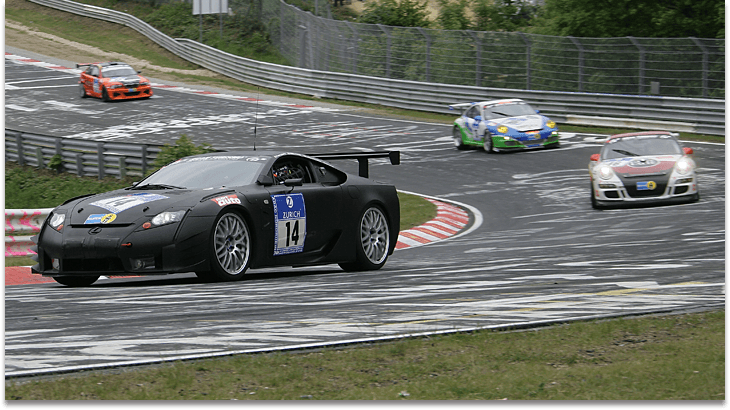
LF-A was entered the SP8 class of the Nürburgring 24-hour race. It was widely known that this model was the LF-A concept car premiered at the North American International Auto Show in Detroit, Michigan in 2005 and 2007. The purpose of entering this LF-A in the Nürburgring 24-hour race was not for promotion or attracting public attention, but purely for development testing.
Whereas other models entering the race had been modified into full-fledged racing machines, about the only modifications made to the LF-A were the addition of regulation-compliant safety equipment and a reinforced suspension to match slick tires. No weight reduction whatsoever for racing was made and moreover, the LF-A was on the heavy side for a racing machine because of the full set of data-gathering instruments installed (adding 200 kg).
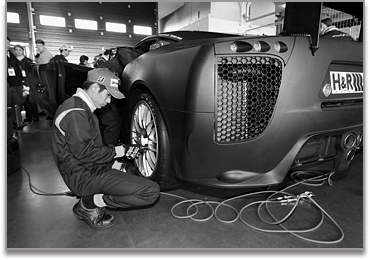 Although the LF-A did well, placing 28th overall in the preliminary round (5th in the SP8 class), it ended 121st out of 150 entries in the finals due to problems such as an oil leak from the oil cooler and damage to a rear hub bolt. Nevertheless, we gained numerous pieces of knowledge that could not have been obtained on a test course. For example, the body that was reinforced to match the slick tires turned out to be extremely effective in providing ease of steering and was incorporated into the later production model.
Although the LF-A did well, placing 28th overall in the preliminary round (5th in the SP8 class), it ended 121st out of 150 entries in the finals due to problems such as an oil leak from the oil cooler and damage to a rear hub bolt. Nevertheless, we gained numerous pieces of knowledge that could not have been obtained on a test course. For example, the body that was reinforced to match the slick tires turned out to be extremely effective in providing ease of steering and was incorporated into the later production model.


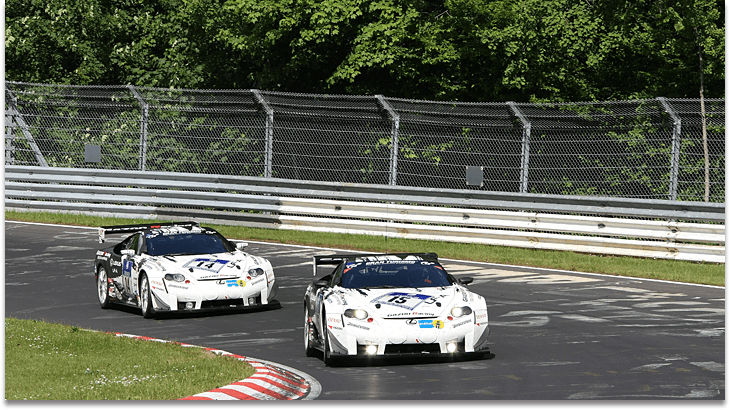
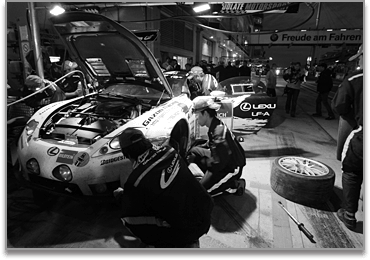 In the preliminary round, Car No.15 placed 23rd overall (2nd in the SP8 class), and Car No.14 placed 24th overall (3rd in the SP8 class). In the finals, however, Car No.15 had to retire because its engine stopped following a powertrain problem, and Car No.14 had to make an extended pit stop because of a problem in its electrical system in the second half of the race, ending in 87th place overall (4th in its class). While the LF-A’s racing strength had definitely increased, the Nürburgring 24-hour race taught us that there was much room for improvement in terms of nailing down problems and refining the machine. Although the race left the LF-A team with a sense of regret, we also learned a lot of valuable lessons that would be beneficial for helping vehicles evolve.
In the preliminary round, Car No.15 placed 23rd overall (2nd in the SP8 class), and Car No.14 placed 24th overall (3rd in the SP8 class). In the finals, however, Car No.15 had to retire because its engine stopped following a powertrain problem, and Car No.14 had to make an extended pit stop because of a problem in its electrical system in the second half of the race, ending in 87th place overall (4th in its class). While the LF-A’s racing strength had definitely increased, the Nürburgring 24-hour race taught us that there was much room for improvement in terms of nailing down problems and refining the machine. Although the race left the LF-A team with a sense of regret, we also learned a lot of valuable lessons that would be beneficial for helping vehicles evolve.

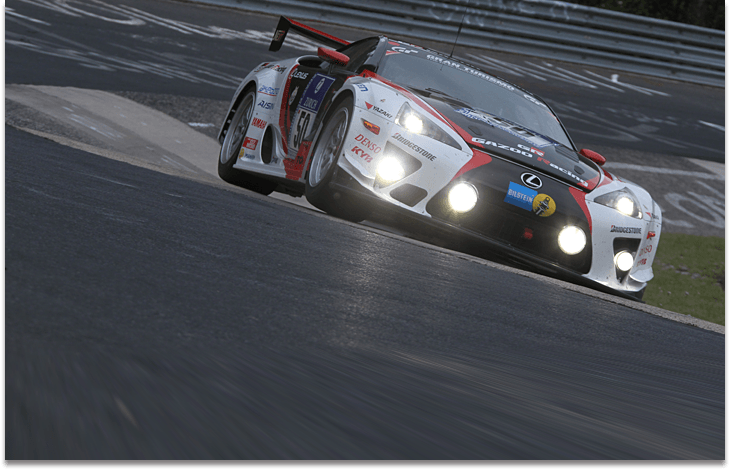
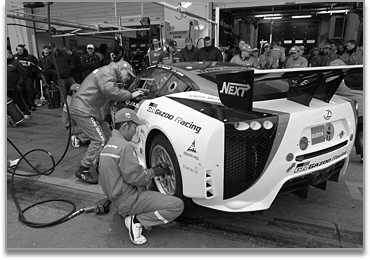 In the finals, Car No.50 retreated greatly in ranking due to a brake problem early on, but hard work by the mechanics and the drivers’ efforts to catch up helped it climb to second place in its class during the late-night hours of the race. The following morning, Car No.50 jumped to first place in its class. Meanwhile, Car No.51 had to have its bumper replaced following contact with another car and then foreign matter entered the engine oil eight hours after the start of the race. Normally, a decision would have been made at that point to retire from the race. Determined to send its machine to the finish line, however, the team decided to go ahead with an engine replacement and worked through the night to restore the car. In terms of results, Car No.50 placed 18th overall (winning the SP8 class championship), but Car No.51 was unable to make the required number of laps and was treated as incomplete. In terms of race results alone, the two cars went separate ways. However, this experience surely had a major impact on the evolution of both the LFA as a car and the people who worked on it.
In the finals, Car No.50 retreated greatly in ranking due to a brake problem early on, but hard work by the mechanics and the drivers’ efforts to catch up helped it climb to second place in its class during the late-night hours of the race. The following morning, Car No.50 jumped to first place in its class. Meanwhile, Car No.51 had to have its bumper replaced following contact with another car and then foreign matter entered the engine oil eight hours after the start of the race. Normally, a decision would have been made at that point to retire from the race. Determined to send its machine to the finish line, however, the team decided to go ahead with an engine replacement and worked through the night to restore the car. In terms of results, Car No.50 placed 18th overall (winning the SP8 class championship), but Car No.51 was unable to make the required number of laps and was treated as incomplete. In terms of race results alone, the two cars went separate ways. However, this experience surely had a major impact on the evolution of both the LFA as a car and the people who worked on it.



